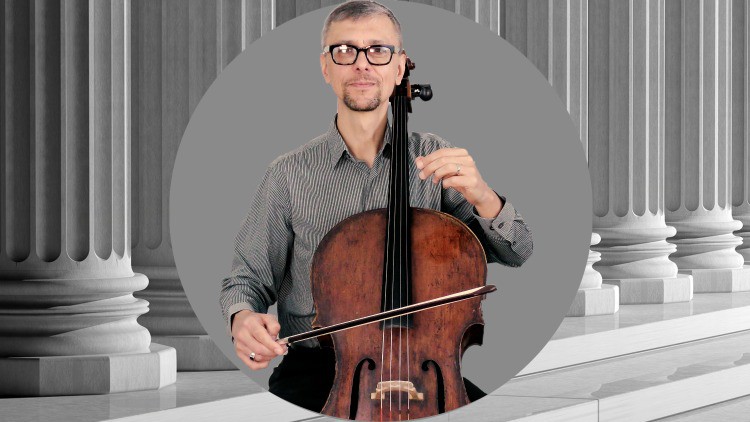Pre-Intermediate Cello Course - Etudes by D. Popper
- Descrição
- Currículo
- FAQ
- Revisões
Have you already learned all basic cello skills and are looking for new music to boost your level, but not sure that you are ready for intermediate level cello music? This course is for you! We will work on making you confident playing more and more advanced music without giving you a lot of stress playing music which requires too many advanced skills.
In this course you will get measure by measure tutorials for each etude, followed by play through in slow tempo. After that, you will try yourself playing together with my recording of the second (teacher’s) part. And, finally we will bring the tempo to the fast speed and enjoy playing it together in the tempo David Popper intended.
We will explore effective strategies to manage and potentially prevent pain in the right shoulder, neck, back, and right thumb. The objective is to help both young and adult cello students cultivate a mindful approach to their posture and body usage, thereby prolonging their enjoyment and fulfillment from playing the cello.
You keep practicing more and more. At this point you might need to learn how to change strings and maintain your cello’s pegs in good condition. I included a video to help you to learn to do it on your own.
I will also show you how to take an advantage of a good rosin. Understanding how to properly use rosin is critical as it provides the necessary friction between the bow hair and the cello strings, allowing the strings to vibrate and produce sound. Incorrect or insufficient rosin application can negatively affect your instrument’s tone quality, making it either too harsh and scratchy or too soft and unclear.
I know that you are busy with so many things to take care of. Although I do not promise for you to be able to play cello well after 1 hour or one day, I will teach you how to achieve good progress while having limited time to practice. We will not be learning to play cello by studying music theory and sitting by the computer. We will do it by trying to play as much as possible.
You will get 4 complete tutorials how to play the etudes 1 to 4 from David Popper’s 15 Easy Studies, Op. 76a. While working on these melodic etudes, you will improve your rhythm, get better understanding of bow distribution, get used to paying attention to breathing to improve your sound quality, start playing staccato, get more creative understanding different moods of each piece and much more!
This course consist of the following parts:
-
The etude no. 1 – G Major scale warm up. Ties, grace notes and subdivisions.
-
The etude no. 2 – C Major scale warm up. Rhythm, mordents and extensions.
-
The etude no. 3 – F Major scale warm up. Accidentals and string crossings
-
The etude no. 4 – A Major scale warm up. Phrasing and breathing technique.
-
Cello maintenance. How to change strings and lubricate pegs.
-
How to Play Cello Without Pain
-
How to Choose and Use Rosin
-
2Part 1 G Major scale warm upVídeo Aula
-
3Part 2 - TiesVídeo Aula
-
4Part 3 - AccidentalsVídeo Aula
-
5Part 4 - Grace notesVídeo Aula
-
6Part 5 - SubdivisionsVídeo Aula
-
7Part 6 - Top part in slow tempoVídeo Aula
-
8Part 7 - Second part in slow tempoVídeo Aula
-
9Part 8 - Bow distributionVídeo Aula
-
10Part 9 - VibratoVídeo Aula
-
11Part 10 - Top part in fast tempoVídeo Aula
-
12Part 11 - Second part in fast tempoVídeo Aula
-
13Part 1 - Warm up with C Major scaleVídeo Aula
-
14Part 2 - RhythmVídeo Aula
-
15Part 3 - Accents and dynamics rangeVídeo Aula
-
16Part 4 - PhrasingVídeo Aula
-
17Part 5 - Mordents and string crossingsVídeo Aula
-
18Part 6 - ExtensionsVídeo Aula
-
19Part 7 - The top part in slow tempoVídeo Aula
-
20Part 8 - The second part in slow tempoVídeo Aula
-
21Part 9 - The first part in fast tempoVídeo Aula
-
22Part 10 - The second part in fast tempoVídeo Aula
-
23Part 1 - F Major scale warm upVídeo Aula
-
24Part 2 - AccidentalsVídeo Aula
-
25Part 3 - String crossingsVídeo Aula
-
26Part 4 - The top part in slow tempoVídeo Aula
-
27Part 5 - The second part in slow tempoVídeo Aula
-
28Part 6 - The top part in fast tempoVídeo Aula
-
29Part 7 - The second part in fast tempoVídeo Aula
-
30Part 1 - A Major scale warm upVídeo Aula
-
31Part 2 - SubdivisionsVídeo Aula
-
32Part 3 - Left hand technique and phrasingVídeo Aula
-
33Part 4 - String crossings and lower stringsVídeo Aula
-
34Part 5 - The top part in slow tempoVídeo Aula
-
35Part 6 - The second part in slow tempoVídeo Aula
-
36Part 7 - The top part in fast tempoVídeo Aula
-
37Part 8 - The second part in fast tempoVídeo Aula












